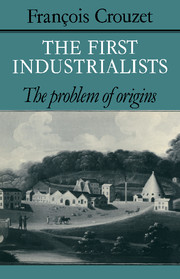8 - Insiders and Outsiders
Published online by Cambridge University Press: 25 October 2011
Summary
If, under Heading IV, ‘craftsmen’ and ‘managers’ (Groups O and P) are added to ‘manufacturers’ and ‘industrialists’ (Groups M and N), it appears that 29% of the individuals in the sample of Table 2 were the sons of men already engaged in industrial pursuits, in a position other than that of wage-earners. Still more striking is the percentage in Table 4 of people who were already in industry at the time when they became industrialists: 42%. As for the members of Table 6, 26% of these had had their first occupation in Groups M to P, while 15% more had set up directly as industrialists.
This proves a kind of endogenesis: industry bred a large number of the leaders who ‘revolutionized’ it. These ‘insiders’ came mostly from sectors of domestic industry which were identical with or closely linked to the branch in which they became factory masters; but they also originated in centralized establishments, sometimes in the same industry, sometimes in an ancillary activity, sometimes in a completely different branch. There were also ‘lateral’ moves, from an industry to a ‘neighbouring’ one which was more attractive and dynamic: a number of cotton-spinners had come from flax, wool and silk manufacturing. However, the main trend was towards integration, either forward or backward, more especially as one must take into account the merchants and traders who were closely linked with industry, because they either supplied it with raw materials or marketed its finished products.
- Type
- Chapter
- Information
- The First IndustrialistsThe Problem of Origins, pp. 116 - 125Publisher: Cambridge University PressPrint publication year: 1985



